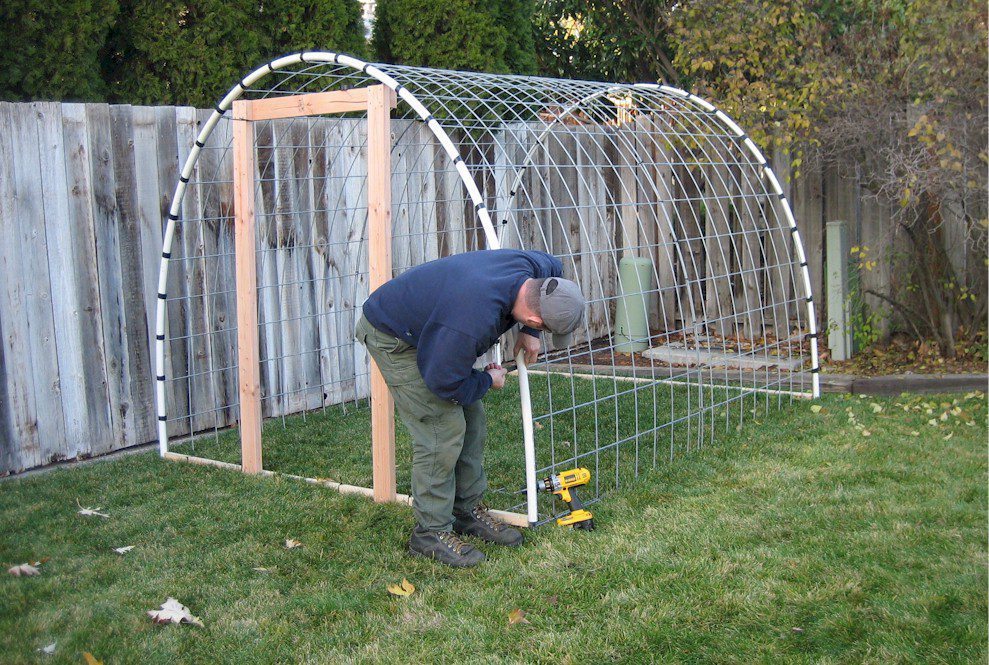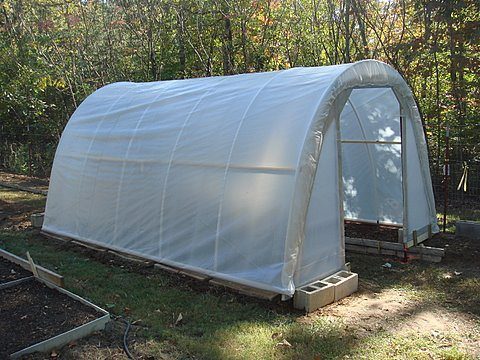Getting your plants going earlier, gardening longer, and growing food in winter has lots of people interested in how to build a greenhouse. Especially after a little window shopping reveals that even the least expensive greenhouse kit is pricey. Which means… it’s DIY time, but if you’re going to do this, you’ll surely want to know you’re building a greenhouse that won’t fly away or collapse.
What kind of DIY greenhouse is best? That depends on where you live. In places with really mild winters, you’ll probably have great success with a super simple, lightweight structure. But high winds and torrential downpours call for stronger engineering. Living in a snow zone? Now you need a wind-proof, weight-bearing design, especially if it commonly piles up high.
Here are a few tips on how to build a greenhouse:
 Tip #1
Tip #1
Do not give your greenhouse a flat roof. Any rainfall will pool up on the roof, causing your structure to collapse. Not cool! Every greenhouse needs a rounded, sloped or peaked roof because the Mother Nature is unpredictable.
Tip #2
Anchor your structure so that it fully covers the ground. Wind getting under the edge will rip the covering, tip the structure over, or carry it away like a balloon. Secure the hoops to a raised bed filled with soil, or to a wood skirting frame bolted to sunken posts or pipes. The greenhouse shown on the right covers most of the important points, but his poly cover isn’t tight on the frame, which can cause problems. You need a relatively taut surface. A better example is found HERE, with a larger structure that includes roll up sides. Ventilation and heat control are important.
Tip #3
PVC pipe hoop greenhouses work in many locations. Be sure to use enough hoops so the poly cover doesn’t sink between them. On a raised bed, covering the framing with inexpensive, plastic-coated woven-wire fencing will give more solidity to the surface before putting on the poly cover. But it’s not for snow zones or a greenhouse the size of a small room. But look at this idea using cattle panel fence sections to create the hoop frame. They’re heavy-duty, and won’t rust, rot, or deteriorate like PVC. However, I suggest adding a support pipe hoop at each panel seam in a snow zone as they do bend.
Tip #4
No matter how small or tall this type of greenhouse is, don’t skip the step of adding a centre roof beam – whether you use wood or pipe. Fastening your hoops to it is important for structural strength, you don’t want them shifting with the wind. Don’t use tape! Screws and zip ties are best. And if you’re building a walk-in hoop house, you’ll need to add the same such pole/board to the side walls about halfway between the top and the ground. Even if you’re doing this in the least expensive way possible, you’ll want it to remain standing and usable for several years.
 Snow Proof Greenhouses:
Snow Proof Greenhouses:
Many people who want to know how to build a greenhouse live where it snows a lot. The heavier and deeper the snowfall, the more weight the roof must be able to hold – especially if the greenhouse isn’t heated. Use 2×4 end wall framing and roof beam with 1×4 hip boards (side wall framing), and a plywood north wall for better insulation. Clear the roof after each heavy snow to remove structural stress.
Perhaps the cheapest greenhouse that can withstand the snow and winter winds is using recycled windows and doors fitted together with wood framing. These can look really cool. You can cut the wood cost down considerably by using reclaimed wood. Make sure all the wood is in good condition – rotten spots won’t hold up long. Caulking along all seams will stop cold drafts. Be sure to include a roof vent or two so your plants don’t overheat on a clear, sunny day. The glass windows can cause leaf scorch on some plants. Add some shade cloth inside to protect them.
You could invest a little more and build a GeoDome. If properly constructed, these endure cold climate winters quite well. Check out this DIY model on an Alberta, Canada homestead (zone 3). It has passive heating and cooling using a car radiator. You can learn how to build a greenhouse just like it HERE.
More Info:
- High Wind Sites
- End Wall Vented
- House Width & Pipe Size
- Wood Framing
Images courtesy of Rodanluo, Door Garden, Adam Fyall, and Northern Homestead – respectively.
[/et_pb_text][/et_pb_column][/et_pb_row][/et_pb_section]
 Tip #1
Tip #1 Snow Proof Greenhouses:
Snow Proof Greenhouses: